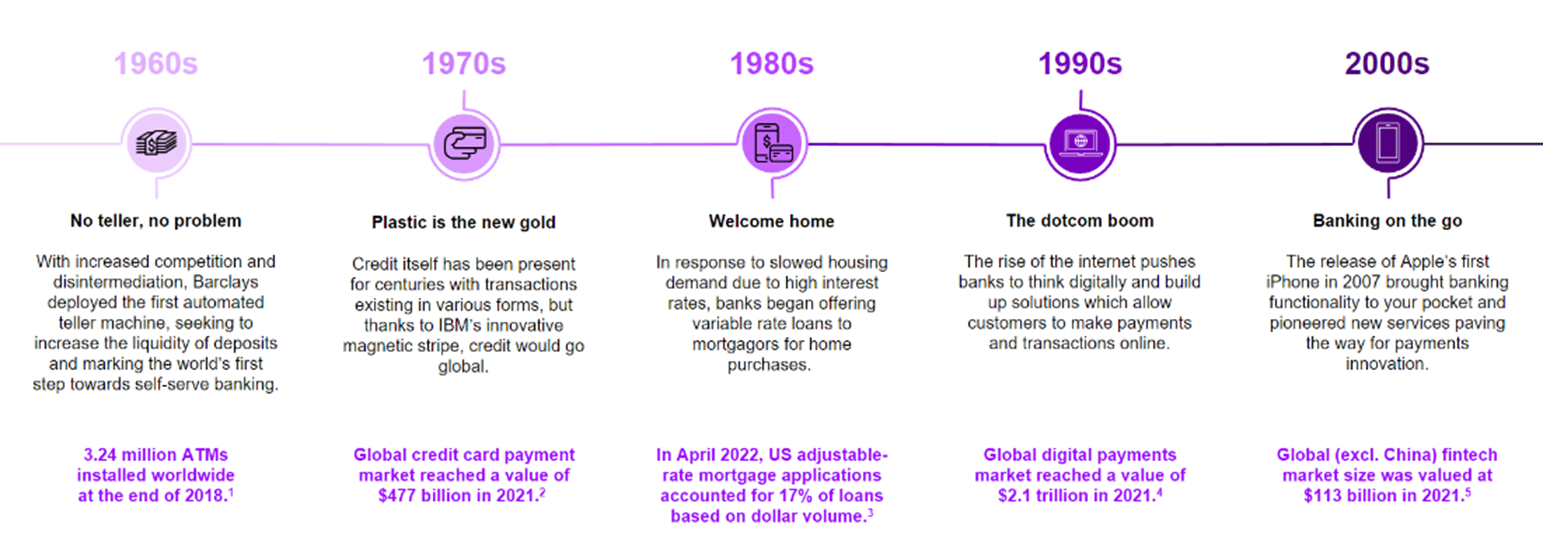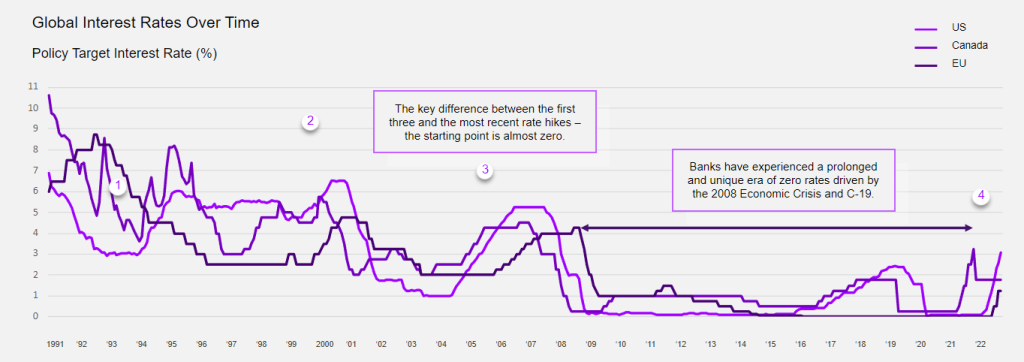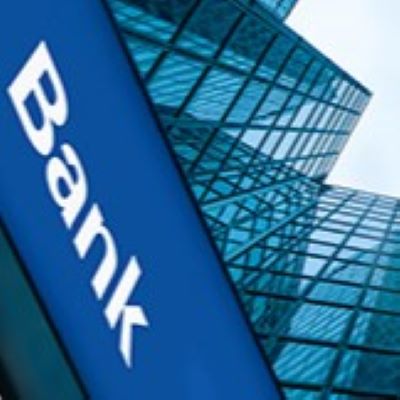The pace of change is not slowing down. Customers’ expectations have radically changed, and they expect much more from their banking products and services than ever before. To maintain relevance, banks need to be on the pulse of these needs and create products to solve them—to unlock value for both their customers and the bank.
The reality is that, over the past decade, banks’ products have converged toward functional equivalence while becoming emotionally devoid. And as banks increased their reliance on digital touchpoints during the pandemic, they became even less connected with their customers.
To add to this paradox, zero rates have distorted the market, driving many banks to focus on individual products instead of the customer as a whole. As rates continue to rise, the limitations of this approach will be exposed, proving a new reality of value for banks.
How can banks spark this change, taking advantage of a rising rates environment to innovate for today’s needs and customer values? We believe there has never been a better time to be in the banking industry, and banks have both the opportunity and the restored profitability to prioritize product innovation and fuel growth.
Banks are well positioned to take a proactive role as they face changing regulations, shifting consumer preferences and rising interest rates. Today, they must rediscover their creative mojo and innovate for today’s customers.
In this guide:
- The history of product innovation in banking
- What impact have zero rates had on banking product innovation?
- What is the opportunity for banking product innovation in a rising rates environment?
- Qorus-Accenture Innovation Awards leading the way in banking innovation
- What are some innovative product ideas that banks can explore now?
- How can banks start accelerating their product innovation?
- Product innovation resources for banks
The history of product innovation in banking
In the decades before the Great Recession, banks relied on unrelenting product innovation to drive growth. From reward cards and no-fee checking to adjustable-rate mortgages, debit cards and instant credit, this innovation has benefitted customers and banks alike.

But over the last two decades, banks have shifted their focus away from innovation. The 2008 financial crisis turned the attention of banks toward economic recovery, adhering to new regulatory standards and driving down costs by digitizing their processes and experiences.
In parallel, changes in consumer needs and the rise of new technologies set the stage for a new operating environment. But innovation did not slow down. Neobanks, fintechs and bigtechs started driving industry innovations such as buy now, pay later lending models and early payday lending.
Today, new competitive threats continue to emerge in all shapes and sizes. Bigtechs are leveraging their consumer data, advanced analytics capabilities and large network effects to partner with nimble fintechs, capturing significant market share across their expanding global footprint—all without a banking license. These non-traditional competitors show ambitions beyond becoming digital banks, and their foray into financial services focuses on creating new sources of value and strengthening their ecosystem by reimagining business models.

Banking Top 10 Trends for 2023: Our annual report predicts the trends that will shape banking’s future.
LEARN MOREWhat impact have zero rates had on banking product innovation?
A decade of zero rates distorted the market by causing a flood of cheap cash and enabling alternative lenders and venture-capital-backed fintechs to fuel the acquisition of emerging and underserved customer segments. During this period, the product calculus changed rapidly, forcing banks to focus on optimizing and marketing individual products rather than developing integrated propositions for customers.
This is revealed in the shrinking role of banks relative to the overall financial system, new competitors and other intermediaries. This trend is apparent in developed economies such as the US, the UK, Europe, Japan and others. This has been partly engineered by regulators seeking to reduce risk within the banking system that became evident in the 2008 financial crisis.
While these regulations and risk controls aimed to build a more resilient economy, the legal, regulatory and policy standards have not evolved to address the new competitive banking environment. The last decade saw an explosion of non-regulated players, such as fintechs, bigtechs and non-banks, and these competitors have attacked the banking value chain to build and serve all the products of a bank without the constraints of banking regulations.
Additionally, during this time, the persistence of zero interest rates resulted in four major directional changes that drove customers and growth outside the banking industry:
- The rise of neobanks
- Personal banking experienced a proliferation of new fintech banks, reaching 250 globally in 2022. Cheap deposits and streamlined experiences powered by more than $300bn in funding helped neobanks open more than 33mn accounts since 2019.
- The explosion of digital lending
- Rock-bottom rates fueled massive off-balance-sheet funding. The number of personal and consumer lenders exploded, while new entrants such as neobanks quintupled the value of digital lending since 2010. (Even Goldman got into the game with Marcus offering personal loans and savings.)
- The disaggregation of SMB products
- Fintechs systematically disaggregated small business banking, with entrants like Square and Kabbage emerging. PayPal acquired Swift Financial to bolster its SMB lending business. Brex built a SMB credit card business. And Shopify and Uber started offering integrated banking.
- The replacement of banks by private equity (PE) firms
- Private credit took off as firms looked to fill the void caused by the retreat of banks from middle-market and other types of ‘riskier’ lending opportunities. PE firms offered high yields for institutional and wealthy investors, outperforming the S&P500, the Russell 2000, and venture capital during a period of low interest rates.
Sources: The Financial Brand, Accenture Research, S&P Capital IQ, CB Insights, SVB, Insider intelligence, Bloomberg
And revenue doesn’t lie—innovation pays. The post-recession difference is evidenced in the soaring revenue growth of fintechs while banks stagnated. Accenture research shows fintech revenues have grown to a material share: $100bn in the US alone. This trend is not unique to the US; new competitors have captured a higher share of revenue in the UK and China, also home to some of the world’s leading neobanks and bigtechs.

What is the opportunity for banking product innovation in a rising rates environment?
Today, amid rising interest rates, macroeconomic volatility and a changing regulatory landscape, banks have the advantage. Strong and diversified balance sheets, trust, economies of scale and experience adapting to change together set the stage for banks to return to their innovative roots.

And just as zero interest distorted product economics, we see the rising interest rates as the gravity pulling business and product strategies back together. This will have a number of impacts:
- Deposits are the new rocket fuel: Low beta deposits are the premium liability every bank wants. Rising rates will drive separation between hot-deposit banks and diversified banks that effectively use digital experiences to manage front- and back-book spreads.
- From product siloes to the total customer: Banks will begin offering holistic value propositions and end-to-end functionality, developing products that link deposits and lending and amplify value.
- Unbundling and rebundling of banking: Banks will deliver growth by unbundling their legacy tech and product distribution and rebundling with partners at lower costs and faster times to market.
- A neo-normal: Neobanks funded by hot deposits are facing pullbacks in investor funding and falling valuations. Banks have a once-in-a-generation opportunity to acquire fintechs to find new customers, accelerate innovation and absorb desirable fintech talent.
- The latent digital dividend: Coming out of the pandemic, 97% of customer touchpoints are either online or mobile. Finding a way to leverage modern data and technology systems to cross/up-sell products in a similar fashion to a branch experience will unlock enormous value in customer relationships.
Qorus-Accenture Innovation Awards leading the way in banking innovation
The Qorus-Accenture Banking Innovation Awards is a global program that honors trailblazers in the banking industry. The 2023 ceremony commemorated a decade of groundbreaking advancements and showcased the year’s most extraordinary and promising innovations.
Bradesco was named Global Innovator 2023 for the bank’s ongoing dedication to innovation, as part of its commitment to delivering world-class experiences to its customers, partners and employees. Bradesco launched several new products and services, including its E-agro platform, that uses data analytics to improve farmers’ access to resources and support, and an internal e-commerce platform that allows employees to request and track corporate supplies.
And there must be an artificial intelligence (AI) mention when it comes to banking innovation. In fact, with its growing popularity, the awards saw this technology infused in most categories. ABN AMRO took the Future Workforce award for ‘ABN AMRO Contact Centre GenAI’. It uses generative AI systems to enable call center agents to swiftly answer customer queries and improve agent performance and job satisfaction.
Intesa Sanpaolo received the Reimagining the Customer Experience award for ‘Ellis: Cognitive AI & GenAI Revolutionize Customer Service’. This intelligent digital assistant operates across the bank’s mobile app, internet banking and public website platforms and uses artificial intelligence to chat with customers.
The awards also highlighted the need to focus on sustainability across categories. BNP Paribas Fortis, for instance, claimed the Beyond Core Banking Offerings award for its ‘HappyNest’ initiative that makes energy efficient housing more accessible by offering new green properties to rental customers who can later buy their homes at a discount.
We encourage you to take a moment and browse the full list of 2023 winning innovations.
What are some innovative product ideas that banks can explore now?
To kickstart the ideation process, we asked our global banking team: “How might we address the evolving financial needs and behaviors of consumers with products and services that can drive revenue growth in an increasingly uncertain environment?”
We pitched over 150 product ideas, with the goal of growth and meeting the needs of today’s customers. We are sharing almost 50 in this guide, categorized by eight product themes, to help banks rediscover their creative mojo for product innovation.
Sumita Bhattacharya, Managing Director – Banking Innovation Lead & NE Innovation Lead
Banks need to break down product silos to enable a holistic view of value and loyalty. The fundamentals of loyalty have changed. With new entrants, access points and innovation, customers today are not only faced with a constant barrage of choices but with exciting possibilities that have enabled the “Age of Switch.”
While loyalty is not dead, it can’t be taken for granted. Consumers are increasingly willing to try brands that will serve them better. They want to see their banks reward them for their loyalty—not just to a single product, but across the bank’s offerings. Recognizing consumers for both the extent of their dependence on the bank and their longevity is more critical than ever and will require banks to demonstrate (and demonstrate again) the value of maintaining this relationship.
- What if we rewarded customers with a combined credit / debit product?
- TD Rewards launched partnerships with Starbucks and Amazon, allowing clients to accrue points for debit spending and to spend points however they want.
- Earn More Starbucks Stars With Your Eligible TD Credit Card and TD Access with Visa Debit Card | TD Canada Trust
- What if we provided benefits like complementary, automatic tax services for those customers who bank solely with us?
- April is an embedded solution that can be integrated into any application to offer customers the ability to seamlessly file their taxes based on their financial data.
- April | Embed intelligent tax experiences (getapril.com)
- What if we incentivized customers to pay off their debts early?
- Tally, a California-based consumer tech start-up built one of the first automated debt managers that helps customers save thousands on credit card interest payments.
- Get Help Paying Off Credit Card Debt Faster — Tally (meettally.com)
- What if we provided extra rewards to customers who support local small businesses?
- Shop Small by American Express is a yearly initiative that incentivizes consumers to shop at its local small-business partners to earn extra cash-back and points.
- Learn more about Shop Small | American Express CA
- What if we delivered and applied rewards in the moment of the transaction?
- Mox Credit introduces the ability for customers to get cash-back calculated right upon purchase and then have it credited to their account daily.
- Mox Credit | Mox
- What if we enabled an intelligent payment picker that automatically selected the optimal payment option at POS?
- VitraCash has launched an industry-first debit card that places a customer's cards in a single wallet and selects the best card for a transaction based on cash-back, insurance and FX fees.
- VitraCash - Home
- What if we helped customers support charitable organizations of their choice through a credit or debit card that splits rewards between them and the charities?
- Novus has introduced the ability for customers to make an impact with every purchase—they earn impact coins that can be donated to 10 different causes.
- Make your money count | Novus
- What if we unlocked access to new benefits and immersive experiences such as earning digital collectible assets through a Web3-powered technology program?
- Mana Interactive helps to unlock rewards for gamers in their purchases and gameplay with the ability to access their account in a VR environment.
- About Us | Mana
- What if we created a program that rewarded customers / SMBs for their total business, adding up their savings and loans to offer greater benefits?
- Tangerine offers a Money-Back Credit Card which rewards customers with an extra 2% money-back when they deposit their rewards in a Tangerine savings account.
- Money-Back Credit Card | Tangerine
Michael Abbott, Senior Managing Director – Global Banking Lead
Rising rates create a window of opportunity for banks to de-commoditize products by developing solutions like those of Amazon Prime that reward total engagement with the bank. Think rewards multipliers for higher deposits, or discounts on mortgage rates—tiered offerings that value the overall relationship. The most creative banks will take it even further by incorporating non-banking products, which means 2023 will be a year of product innovation.
- What if we helped students manage their money with a digital attacker product that personalized services?
- CIBC launched Smart Start to offer zero-cost banking accounts until customers turn 25, supplemented with no-fee stock and ETF investing as well as SPC+ membership to help set young adults up for success.
- Get Unlimited Everyday Banking for Youth Under 25 | CIBC
- What if we provided renters loans with pre-verification to help them get the homes they need?
- SingleKey offers tenant screening that goes beyond credit scores and a rental guarantee should a tenant stop paying rent.
- Rent Guarantee & Tenant Background Checks | SingleKey
- What if we helped customers maximize spend and enjoyment instead of savings?
- Citi Bank launched Custom Cash, a new type of cash-back card that provides 5% rewards on a customer’s top spend category. It incentivizes them to buy the things and experiences they love.
- Citi Launches Custom Cash—A Next-Gen Cash Back Credit Card
- What if we could foster community-oriented customer loan marketplaces?
- Zirtue is a relationship-based lending platform that allows users to lend money to friends and family, setting their own repayment terms and conditions.
- Zirtue | Lend and Borrow Money with Friends & Family | Relationship-based Lending
- What if we integrated personal accounts with shared-expense tracking and reimbursement of housemates or partners on a single platform?
- Splitwise offers a single interface for those in relationships or living with roommates to help track bills and expenses and easily make transfers to settle balances.
- Split expenses with friends. :: Splitwise
Jess Murray, Managing Director – Song, Banking & Capital Markets Lead, North America
Banks face a trust paradox. While customers trust banks with their money, only 19% of them say they are interested in receiving advice from a bank. And the expectation around life-centric advice has only increased throughout the pandemic.
To this end, we are witnessing leading banks “democratize advice” products and services typically provided to wealthier investors, making advice more accessible to the mass-affluent segment through analytics and digital advice tools that deliver more meaningful, contextual, personalized experiences.
- What if we optimized your savings rate by automatically moving your money to the best rate?
- Max is a tool that helps customers earn more by presenting the highest-yield accounts so they can maximize their interest on their savings, emergency and sinking funds.
- https://www.maxmyinterest.com
- What if we gave individuals the opportunity to collateralize against their personal assets?
- Yendo is a revolving credit product on a mobile platform that taps into an individual’s equity in their vehicle regardless of credit history or score.
- https://www.yendo.com
- What if we used a ‘what if’ tool to simulate past and future financial scenarios against potential product / service options?
- PocketSmith, a financial software product from New Zealand, includes a comprehensive scenario planner that allows customers to create and test different financial situations on multiple accounts to predict financial outcomes.
- https://www.pocketsmith.com/global-personal-finance-software/new-zealand/
- What if we supported the financially excluded with community-based grant-backed advisory programs?
- Ikigai, a new challenger app in the UK, enables customers to access a relationship manager for a flat $10 subscription fee, making financial advice available regardless of how much the customer can invest.
- ikigai - Self-care for your money
- What if we delivered advisory services through a metaverse platform?
- Cogni is a digital banking challenger app that blends personalized financial and exciting lifestyle services access across Web2 and Web3 finance.
- Welcome to Cogni • Banking 3.0 (getcogni.com)
- What if we drove on-demand support with branch managers / advisors with a Calendly-like tool?
- Finmarie, a German-based financial start-up that targets women enables its customers to use an app to set up bookings with its specialists for one-to-one personal financial coaching.
- Financial freedom & wealth accumulation for women | Jennifer (finmarie.com)
- What if we made it easier to achieve homeownership with a leasing model?
- Key, a Toronto start-up, brings co-ownership and leasing to the homeownership market. Customers put 2.5% down and build equity with each monthly payment.
- Home Page (lifeatkey.com)
- What if we brought hedge-fund-like pricing to consumer asset management?
- Sweater is a fintech firm that is making venture capital funds accessible to everyday customers with a clear fee structure across their investments on the platform.
- Sweater | The VC Fund for Everyone (sweaterventures.com)
- What if we customized financial-goal-setting and money-management platforms, making them responsive to different scenarios (e.g., travel, splurge, save)?
- Standard Chartered launched Autumn, a platform that provides a single dashboard view of a customer’s financials and can be used to personalize goals or analyze scenarios.
- Autumn - Your Finance & Wellness App
- What if we benchmarked consumers against their peers with a 'how I'm doing' FICO-like score, along with advice on how to improve?
- FRICH is a new social banking app aimed at millennials and gen Z, where users can compete in community challenges to see how their financial position compares with others’.
- Social Finance for Gen Z | Frich (getfrich.com)
- What if we met the personalized and dynamic needs of different customer groups with curated ‘backed by bank’ financial tips from accredited financial advisors and bankers?
- NatWest emerged on TikTok to promote an online toolkit with learning modules on sustainability, business strategy and mindset designed to inspire entrepreneurs.
- NatWest Online – Bank Accounts, Mortgages, Loans and Savings
Sumita Bhattacharya – Managing Director, Banking Innovation Lead & NE Innovation Lead
Banks need to focus on solutions that address the diverse needs of consumers and communities. Consumers of all ages and locations are increasingly embracing brands that act with purpose. In a Forbes study, 88% of consumers said they wanted companies to help them make a difference in their communities.
In 2021, nearly 20% of the US population remained unbanked or underbanked. Many consumers also struggle to make the right choices when it comes to managing their financial futures. Organizations that innovate to provide greater access to credit and capital can win with a wider segment of consumers who haven’t been served or served well.
- What if we made credit accessible to those with bank accounts but who lack exposure to credit products by giving them an alternative credit score?
-
- Petal creates a Cash Score using consumers’ banking history. It draws on factors such as income, spending and savings rather than a traditional credit score.
- Petal - Responsible credit for the modern world. (petalcard.com)
- What if we incentivized underserved and bank-averse groups to open new and relevant products?
- The Community Affordable Loan Solution, offered by Bank of America, aims to make homeownership a reality for members of predominantly minority communities—basing eligibility on income and location.
- Bank of America Introduces Community Affordable Loan Solution™ to Expand Homeownership Opportunities in Black/African American and Hispanic-Latino Communities
- What if we qualified customers for lines of credit based not on credit reports but on how they manage their checking and savings accounts?
- Huntington Bank has launched Standby Cash, which allows clients to qualify for a small line of credit based on their checking account and payment history rather than credit score.
- Building Credit With No History: Does Standby Cash Affect Credit? | Huntington Bank
- What if we provided banking services to remote and underserved communities through partnered solutions?
- The Walmart Money Center enables customers to access multiple financial services, from cash and money transfers to insurance and tax services, at their local Walmart.
- Money Center - Walmart.com
- What if we rewarded sustainable financial behaviors with relevant benefits that reinforce these behaviors?
- Stellantis partnered with Kiri Technologies to design a new rewards program that encourages Fiat 500 electric-car drivers to adopt an ecological driving style based on their speed and energy usage.
- e-Mobility by Stellantis presents with Kiri Technologies the innovative program dedicated exclusively to New 500 customers, to reward sustainable driving | e-Mobility | Stellantis
- What if we created a team to help corporations’ employees get better at saving?
- Visa has announced the launch of an advisory service for financial institutions, retailers and other businesses looking to engage in Web3, crypto and the metaverse.
- Visa Introduces Crypto Advisory Services to Help Partners Navigate a New Era of Money Movement | undefined
- What if we used financial products to meet the needs of people with physical disabilities, situational disabilities and socio-economic restrictions?
- HSBC UK’s efforts toward financial inclusion led to the introduction of higher- contrast colours and tactile raised dots as standard features on its bank cards, making it easier to differentiate between different cards.
- Accessible Cards | Accessibility - HSBC UK
- What if we helped customers to access their money in different currencies without fees?
- PKO Bank Polski offers debit cards that can be used in multiple currencies. This enables customers to make payments without currency conversion costs.
- PKO Bank Polski (pkobp.pl)
- What if we allowed customers to 'save now, buy later' through dedicated savings plans in which participating retailers contribute saving incentives to encourage sales when the required amount has been accumulated?
- As a new start-up based in India, Tortoise aims to upset purchasing products with a 'save now, buy later’ program. Customers enroll in a savings plan and get cash-back which they can use for their purchase.
- Tortoise Savings App
- What if we enabled customers to support initiatives aligned with their environmental, political and social values by designating where the money they save should be invested?
- Standard Chartered has launched Shoal, where customers can specify the green projects in which their savings should be invested. They then get updates on the funded projects as well as a ‘competitive rate of return’.
- We've launched Shoal (sc.com)
Jess Murray, Managing Director – Song, Banking & Capital Markets Lead, North America
I’ll introduce my excitement for the potential in this space by quoting Serena Williams: “I have never liked the word retirement. It doesn’t feel like a modern word to me…Maybe the best word to describe what I’m up to is ‘evolution’.”
And I agree—retirement is a dated concept and banks have long neglected the opportunity to rethink the experience. Generationally, we are seeing boomers thrive as they age and develop new needs in this phase of life, including anything from second careers to the rise of the ‘silver divorce’. In parallel, younger generations are redefining the meaning of success, and have accelerated the FIRE (financial independence, retire early) trend.
Add to these the aging population and the inter-generational wealth transfer, and it becomes clear that attitudes around ‘retirement’ as an ultimate, monolithic goal have changed. Banks must shift to longer-term planning focused on health and wellness.
- What if we provided a lifestyle paycheck that enabled tax-optimized 401k / pension drawdown based on the customer’s lifestyle and changing retirement goals?
- Timeline helps financial advisors to plan for their customers’ future based on specific goals and modelling different investment outcomes.
- Empowering Financial Advisers and Financial Planning Firms | Timeline
- What if we provided concierge-type services to help manage the financial implications of a person’s death (e.g., closing accounts)?
- ClearEstate is a Canadian estate settlement tool that gives users access to a beneficiary portal and dedicated estate professionals and executor coaches.
- ClearEstate | Online Estate Planning and Settlement Service
- What if we calculated a customer’s FIRE (financial independence, retire early) number—the amount they need invested—and embedded advice on how to accelerate toward this number?
- Finary is an aggregation tool that enables customers to track multiple asset classes and their associated performance to predict and simulate financial independence.
- Finary | Real-Time Portfolio Tracker & Stock Tracker
- What if we connected retired customers through a virtual community?
- Papa pairs seniors and retired individuals with companions who can lend a hand, take walks and reduce social isolation by building relationships
between generations. - Papa | Companionship for Older Adults | Flexible Family Care
- Papa pairs seniors and retired individuals with companions who can lend a hand, take walks and reduce social isolation by building relationships
Jared Rorrer, Managing Director – Global Commercial Banking Lead
With the current economic uncertainty, banks’ immediate focus going into 2023 will be on doing the basics well. Be it ensuring the new LOS is adopted effectively to enhance credit quality or improving data quality or basic process effectiveness and control, the name of the game will be ‘finish what you started and make the bank hum’.
But don’t be fooled: the window to complete the basic blocking and tackling will be short-lived. When we emerge from what will hopefully be a light recession, the progress to digital will accelerate. Banks must be ready to build on the foundational work they have been doing and to deliver fully digital experiences. They should also strive to bring their data to life using AI, to drive smarter solutions from AML/KYC and onboarding to risk decisioning and customer outreach.
- What if we could create a digital memory of a corporate customer?
- Kabbage from American Express is a cashflow management offering that provides funding based on a customer’s financial information, with the decision delivered within minutes.
- Tools to help grow your business | Kabbage from American Express
- What if we matched sellers and buyers to take over used equipment and assets and help with the financial arrangements?
- Moov is a data-driven marketplace that brings together buyers and sellers of surplus manufacturing equipment, while also handling payment and logistics to reduce lead times.
- Used Semiconductor Equipment Marketplace | Moov
- What if we dynamically adjusted pricing based on expected customer lifetime value?
- Atelier gives lower-interest loans to smaller property developers who make substantial reductions in the lifetime carbon impact of their developments.
- Atelier rewards property developers who go green with cheaper finance (finextra.com)
- What if we give customers greater control over the selection of the right relationship manager for them?
- Italian bank Illimity has introduced b-ilty, a subscription model for SMB financing. SMBs receive personalized financial services with a dedicated relationship manager.
- illimity, b-ilty
- What if we integrated financing and our customers’ supply chains into one platform, providing verified turn-key supplier and distributor networks to order financing?
- Klarna recently partnered with Liberis to provide personalized and pre-approved financing offers, all from the Klarna platform.
- Klarna Collaborating With Liberis | PYMNTS.com
- What if we white-labelled our technology as a product which other financial institutions and start-ups (e.g., treasury services, payment services, APIs) could use?
- Nymbus has a banking-as-a-service offering that enables customers to launch a fully secure and compliant digital bank or credit union.
- Banking-as-a-service (BaaS) | Nymbus
- What if we could expand our ecosystem and provide banking services (e.g., ‘buy now, pay later’ credit products, small business loans) to support our SMBs and their customers?
- Railsr offers a new way for retailers to create exceptional customer experiences through white label solutions such as buy now, pay later and rewards programs.
- Railsr, Formerly Railsbank | The Global Embedded Finance Platform
- What if we could manage commercial leasing / lending for metaverse real estate and cryptocurrencies?
- Milo is driving Web3 lending by launching the first crypto mortgage that enables customers to purchase land and real estate in digital forms.
- Milo | 30 Year Crypto Mortgage Loan
- What if we connected businesses with specialized relationship managers to exchange ideas, supported by market intelligence and bank analytics?
- Comarch’s Relationship Manager Assistant provides RMs with a 360° view of customers and offers advanced tools that automatically assign leads to the right team.
- Digital banking software, IT business products for banks (comarch.com)
Jared Rorrer, Managing Director – Global Commercial Banking Lead
Banking is necessary for SMBs to operate their business, but it is often not top of mind. Market innovation and the advent of embedded banking is changing how SMBs interact with banking products. New value-added services and new, more convenient channels are making it easier for SMBs to access their banking services.
SMB owners are willing to pay a premium for services that save time, and we expect new SMB banking experiences to drive $92 bn of market growth. There is pressure on banks to radically simplify the SMB experience and provide an ecosystem of solutions that help these customers manage their businesses and solve their biggest pain points.
Banks that are not prioritizing investment in this segment risk losing customer mindshare to non-banks (e.g., Shopify or Amazon) and neobanks that are providing niche financial offerings.
- What if we tailor-made debt solutions or business tools to help SMBs implement social, environmental and governance initiatives?
- NatWest has recently unveiled Climate Hub, a tool that supports SMBs to better understand their climate impact and access information on green loans and green asset financing.
- Make a change today for a greener tomorrow | NatWest
- What if we integrated all of SMB customers’ banking and non-banking needs through a single super-app?
- Nuula is a super-app that helps SMBs track their business metrics (cashflow, credit etc.) and access loans and lines of credit. It also offers private wealth management.
- Nuula | Your business at your fingertips
- What if we used our physical locations to support small businesses (e.g., pop-up shops, meeting spaces)?
- Storefront is a technology platform on which property owners can list their space, from a shop to an office block, making it easier for them to monetize underused physical locations.
- Storefront | +10,000 pop-up shops, showrooms, event venues to rent (thestorefront.com)
- What if we rewarded our retail banking customers for transacting with a featured list of SMB customers?
- Mastercard Local is a new rewards program which, in partnership with banks and credit unions, offers customers 5% cash-back when they support their community by shopping local.
- Shop at Local Businesses and Earn Cashback | Mastercard Local
- What if we elevated the banking experience for SMB customers by providing them with relationship managers such as those which corporations work with?
- Canadian Western Bank collaborated with Temenos to develop a new offering for SMBs: Temenos Virtual COO. It supports decision making with insights drawn from business and financial data.
- Temenos Core Banking and Canadian Western Bank - Success Story
Michael Abbott, Senior Managing Director – Global Banking Lead
While banks are fiercely competitive, banking itself is built on a foundation of collaboration. There are many areas in the industry where banks are simply better together. No bank gets a gold star for being the best in compliance, and payments would never work if everyone used a different protocol. The advent of commercially-driven embedded banking, the movement beyond payments to standards for loyalty and rewards, and the explosion in AML/KYC (and its associated costs) together are giving banks cause to think beyond their four walls and find new ways to collaborate even more.
- What if we further enabled the bank app and allowed it to become your mobile wallet?
- Apple Pay is a payment service that replaces all of the customer’s physical cards with a single wallet enabling contact-less payments, transaction dashboards and secure purchases through a single interface.
- Apple Pay - Apple (CA)
- What if we used QR codes to empower easy bill payments, person-to-person payments and other transactions?
- Facebook has recently announced the launch of special QR codes for easier in-app payments working between Messenger users in the US.
- Meta Pay: Simple, Secure, Free Payments (facebook.com)
- What if we offered credit using an industry-wide network-based ‘buy now, pay later’ service?
- OatFi helps drive B2B payments through an API-powered credit stack, enabling any business to launch its own ‘buy now, pay later’ offering for its customers.
- OatFi | Working Capital Infrastructure for B2B Payments
- What if we standardized international credit scoring so that banks could work together and share information on credit scoring and fraud risk?
- Nova Credit is a new-age credit bureau that unlocks a customer’s international credit history and risk profile by accessing consumer-permissioned data.
- Nova Credit
- What if we created a coupon discount delivery network that worked across banks similar to how Visa and Mastercard work for payments?
- Honey is a browser extension tool that drives savings for consumers by applying coupons and discounts from across the web to their online purchases.
- Automatic Coupons, Promo Codes, and Deals | Honey (joinhoney.com)
- What if we collaborated with other banks to create a single sign-on feature that uses visible information and biometrics to simply share transaction data and information among all participating banks?
- Akoya enables financial institutions, from big banks to neobanks, to securely exchange consumer data such as balances, loans, investments and credit limits.
- Akoya | Financial data APIs for Open Finance

PAY NOW OR PAY LATER? The U.S. banking industry’s next move
READ MOREHow can banks start accelerating their product innovation?
So, now you have a few product ideas. But it takes more than ideas to succeed. Cultivating a culture of obsessive innovation is important, but it’s not enough. Today, banks should:
- Stop...
- Operating in product silos. Break down internal silos to avoid competing on price or submitting to rate maximization apps. Banks should develop offerings linked across products to help customers manage inflationary pressures and meet their financial goals.
- Asking what other banks are doing. Banks that focus on catching up with neobanks or direct competitors will only be fast followers, capable of developing table-stake experiences at best. Stop comparing yourself to the bank down the street, or within the confines of your current projects. It’s time to innovate, not imitate.
- Start...
- Building innovation muscles. Incorporate routines such as monthly product value hack sessions and ideation challenges. Include non-team members in these sessions to include outside perspectives. Re-evaluate and prioritize product backlogs regularly.
- Getting ready for M&A. As rates continue rising and fintech and challenger bank valuations fall, this could be a once-in-a-decade opportunity for banks to improve their long-term ROE through acquisition. In the process they could bring onboard valuable next-generation talent.
- Continue...
- Measuring what matters. Continue to develop metrics that not only drive value-based decisions for innovation on a micro and macro scale, but also enable operational accountability.
- Addressing the customer as a whole. Banks will need to continue to innovate on both sides of the balance sheet and look for ways to reward customers for borrowing as well as depositing money.
- Elevating the partner ecosystem. The evolution of powerful ecosystems provides the capabilities and technology required to scale innovation, and now is the time to double down on building a robust external network.
Product innovation resources for banks
Qorus and Accenture Announce Winners of 2023 Banking Innovation Awards
Building a culture that drives sustained growth
To continue these product innovation conversations, connect with us.
Special thanks to Rebecca Weill, Accenture Consulting Analyst, for contributing to this blog.











